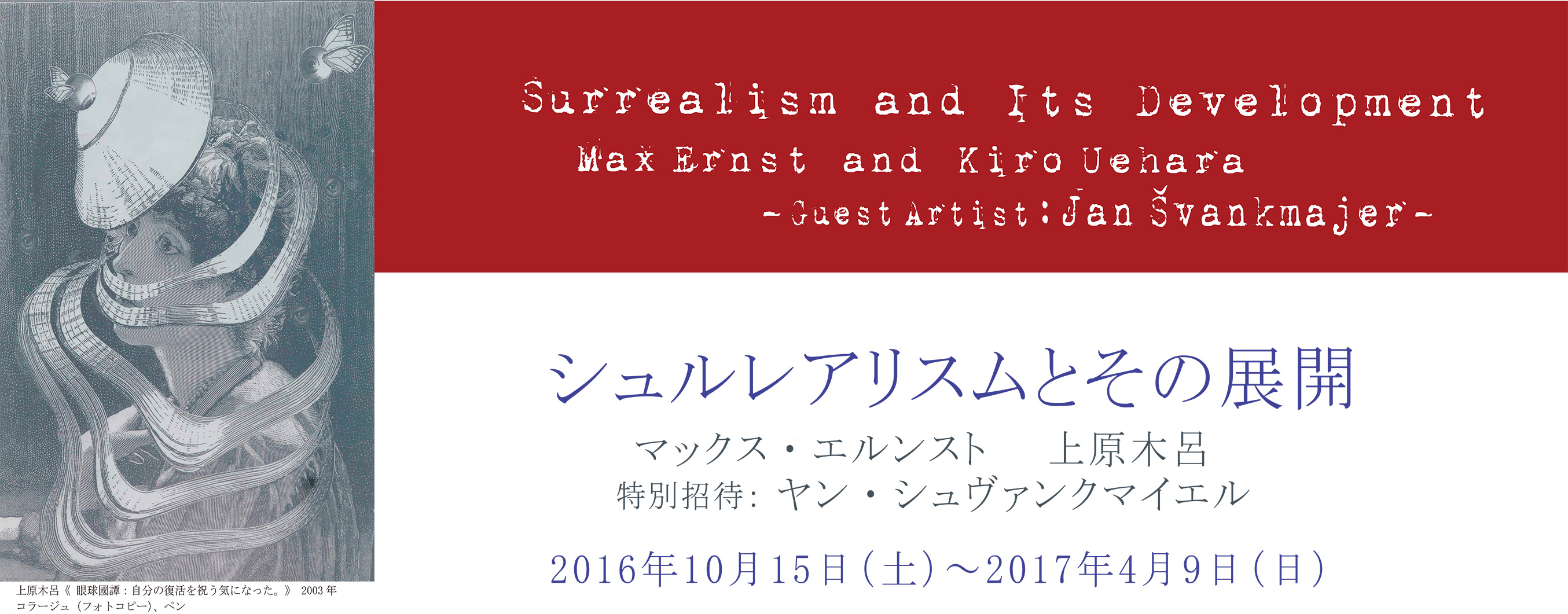Surrealism and Its Development: Max Ernst and Kiro Uehara―Guest Artist: Jan Švankmajer―
Information
- Period
- 2016.10.15 - 2017.04.09
- Preview
- 2017/01/28
- Venue
- Karuizawa New Art Museum
Exhibition Room (2nd Floor) - Open Hours
- October - April 10:00-17:00
* Enter by 30 minutes before close - Closed
- Every Tuesday (If Tuesday is a Holiday, following day as Holiday. No Holidays in August)
- Incidental
- December 27th-December 31st and January 1st, 2017 are days closed.
- Ticket
- General admission: ¥1000 (TBD),
Visitors over the age of 65, high school and university students: ¥800 (TBD),
Primary and secondary students: ¥500 (TBD)
* ¥300 discount from above fees for groups over 20 people
* Preschool children, Disabled : Free, discount for an attendant (half of above fees) - Contact Information
- Karuizawa New Art Museum
Tel. 0267-46-8691
Exhibition Section
About the Exhibition
Right after WWI, the shock waves created by Dada led to the birth of Surrealism, which sought to free every being from rationality and morality to reach the absolute reality, or surreality.
Max Ernst (1891-1976) practiced collage, which creates the illusion that the illustrations from books link with one another spontaneously; and frottage, a technique of obtaining patterns by rubbing over materials like wood grain.
For the exhibition 《Surrealism and Its Development: Max Ernst and Kiro Uehara―Guest Artist: Jan Švankmajer―》 the Karuizawa New Art Museum is pleased to show his first of a three-part series of collage novels (collage-roman) "La femme 100 têtes" which was first published in 1929. In the 1920s, as exemplified by the techniques of ‘collage’, which juxtaposes contradicting, opposite ideas; and ‘frottage’, which traces the textured surfaces of objects, Ernst opened up new avenues of expression.
Kiro Uehara (1948-) met Shuzo Takiguchi at an early age and associated himself with Surrealism. Amazed by Max Ernst’s collage novels (collage-roman), Uehara continued to seek the quintessence of Surrealism. After producing collages in black and white for"Story from Eyeland" (2003) that have the traces of cut-and-paste and handwriting left, he moved on to the creation of "Time- Kaleidoscope "(2009-2010), a series of vividly colored collages to establish Japanese Surrealist painting. This exhibition introduces Uehara’s diverse artistic works, ranging from collages to his current genre of art, Abstract Expressionist paintings.
As a guest artist, we also feature Jan Švankmajer (1934-), a Surrealist from Czech, who, like Uehara, is inspired by Ernst.
We hope you enjoy a wide array of creations by the three artists, who demonstrate their free, outside-the-box ways of thinking nurtured by Surrealism.
Sponsorship
General Incorporated Foundation Karuizawa New Art Museum
Support
Nagano-prefecture, Nagano Prefectural Board of Education, Karuizawa-machi, The Shinano Mainichi Shimbun, SHIN-ETSU Broadcasting Co., LTD, Nagano Broadcasting Systems, Inc. TV. Shinshu Broadcasting Co. LTD., Asahi Broadcasting Nagano Co., Ltd. Karuizawa, the Paper (ADAID, Inc.), KaruizawaNEWS, FM KARUIZAWA, Promotional Council for Karuizawa, International City of Arts and Culture.
